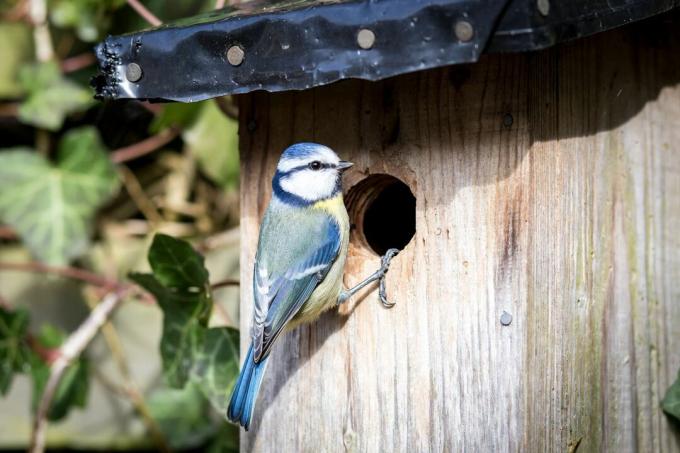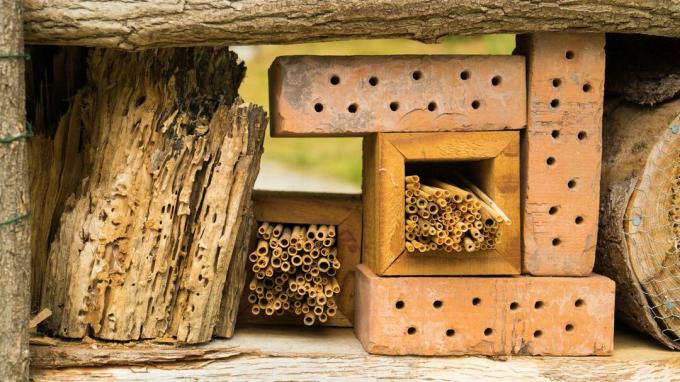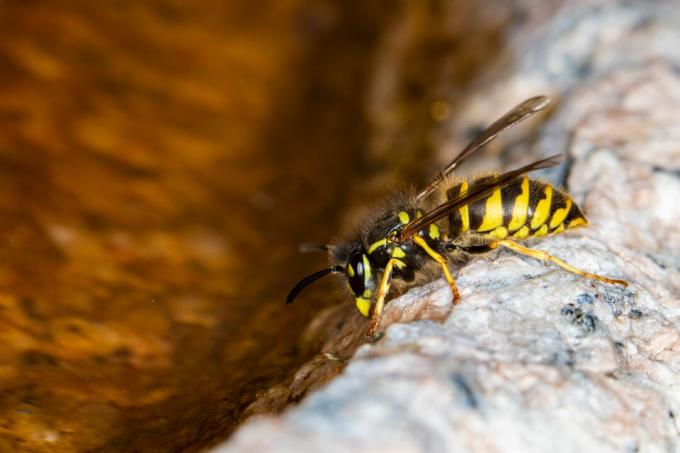If you have a green thumb, you usually care about the environment. We show how to protect nature in the garden all year round.

Only with an abundance of different plants and creatures does our nature remain alive and in balance. Structurally poor habitats, surface sealing or the use of pesticides have an effect on the natural one ecosystem and simply lead to fewer opportunities for native plants to survive and animals. The garden is therefore an important alternative. With just a few simple steps, you can create your own nature reserve here. In the following we will show you tips and tricks for effective nature conservation throughout the year.
contents
- 1. Build a dry wall
- 2. hang up nest boxes
- 3. Overgrown corners for caterpillar food
- 4. Practice natural floor care
- 5. Set up a hotel for insects
- 6. Sow bee pasture
- 7. Set up insect waterers
- 8. facilitate hibernation
It doesn't take much to protect nature with the help of your own garden. With natural materials, a little creativity and time, an oasis of well-being for various animal and plant species is created. For practical implementation, we have compiled 8 tips for nature conservation in your own garden for you here.
1. Build a dry wall
One drywall in the garden is not only an eye-catcher, but also offers a real paradise for insects, birds, wall plants or reptiles such as lizards thanks to its cracks and joints. This sun-loving animal can, for example, soak up heat on the stone surfaces while bumblebees and wild bees find shelter in the cavities. Native bird species like this robin or the wren go insect hunting between the stones and can even nest in larger niches. Plants that find a suitable place to grow in the drywall include stonecrop, cynomolgus and saxifrage, as well as mosses and ferns. Natural stones from the region should be used for construction, which, as the name suggests, are then stacked on top of each other without sealing the gaps with mortar.
2. hang up nest boxes
There is a housing shortage for the birds. Hedges, meadow orchards and open landscapes with rotten trees are becoming fewer and with them natural nesting opportunities for numerous species of birds or mammals such as bats. For this reason, nesting boxes guarantee a safe place for breeding, sleeping and overwintering. Of course, they are mainly intended for raising the young in spring, but they also fulfill important tasks in winter. Birds have a higher body temperature than humans, which must be maintained by constantly burning fat. That takes a lot of strength and without a warm nest to sleep on cold nights it can quickly be a matter of life and death.

Which bird species moves into the nest box depends on the size and the entrance hole of the box. A hole diameter of three centimeters is popular with almost all native songbirds. blackbird, wren or black redstart prefer to breed in crevices or niches and therefore prioritize half-open nest boxes. A large number of different nesting aids are available on the market. But who get creative and build your own nest box If you want, you can of course also do this and. It is important that the bottom of the box is at least 12 x 12 centimeters and that untreated, durable wood such as oak or larch is used.
Providing feeding stations is also a great addition to a bird-friendly garden. With our Plantura all-season feed for example, you can do something good for a variety of wild birds all year round.

Plantura year-round food for wild birds
High-protein year-round bird food
for all grain and soft feed eaters,
supports bird parents & their offspring
3. Overgrown corners for caterpillar food
while the butterflies like bees and scour the garden for plants full of nectar, the caterpillars seek out the green foliage of native plants. So if you want butterflies in your garden, you should make sure that there are enough food plants for the caterpillars. Unlike the adult animals, caterpillars are sometimes very strongly specialized on certain plants. So you can find the caterpillar of the swallowtail on umbellifers like the carrot, to the dill or the fennel and the caterpillar of the brimstone butterfly in the alder buckthorn. One plant that is popular with several caterpillars is the stinging nettle. Admiral caterpillars, painted lady, maple leaf, peacock butterfly, small tortoiseshell and C-moth find a tasty source of food here. To "weeds" like nettle or thistle in the garden, it is best to let unused corners of the garden run wild. Here the caterpillars can go about their feeding in peace. Plants that are also visited by several caterpillars are sorrel, buckhorn, horseshoe clover or the willow.

4. Practice natural floor care
Not only our vegetable garden enjoys natural soil care, but also countless soil creatures and insects. Measures for this are, for example, mulching, reduced tillage and green manure. Mulching keeps your soil covered, which means that moisture is better retained in the soil and nutrients cannot be easily washed away by rain. The soil creatures also find it optimal under these conditions and are very busy breaking down mulch material and making it available for the plants. Instead of turning the ground, the digging fork can be used for certain tasks. This only loosens the soil and protects the soil structure, which has a positive effect on air and water circulation in the soil. Even worms can easily dig their tunnels. After the gardening season is before the gardening season. Instead of leaving beds fallow, green manure plants can be sown, which improve the soil over the long term. Deep-rooted plants like oil radish or bitter lupine, for example, loosen the soil while lupins, vetches and clover bind atmospheric nitrogen through root bacteria. Through green manure flowers such as phacelia or marigolds also attract bees. In our special article with Soil improvement tips, you can find out more about natural floor care.
5. Set up a hotel for insects
A hotel for insects? Sounds strange at first, but it is incredibly important, because many insects have the same problem as birds: too few nesting and shelter options. We need useful insects, for example for pollination or pest control. The insect hotel creates space for a wide variety of residents with its various "rooms". You can encounter different wild bee and wasp species, bumblebees, ladybug, lacewings or earwigs. In order to inspire as many insects as possible for your hotel, a variety of natural materials should be used. A wooden frame serves as the basic structure. This can then be filled with bamboo stalks, cardboard tubes, clay bricks or hardwood. There are hardly any limits to the imagination.

6. Sow bee pasture
Bees love plants that provide a lot of nectar and pollen. These include, for example, meadow sage, Lavender, Horn clover, mallow, marigold or that snapdragons. The more extensive the offer, the better, because this way the preferences of different bee species can be met. Because not only the well-known honey bee is looking for nectar and pollen, but also a large number of wild bee species, such as the spring fur bee or the poppy mason bee. Experts estimate that there are around 500 wild bee species in Germany. However, their stock is steadily decreasing. So it's high time for a delicious bee pasture. the Plantura bee pasture is excellent for this. It doesn't have to be big, even a few square meters of wildflowers will provide additional food. A good time to make one create bee pasture, is March to May. In order for the plants to flower for a particularly long time, not all the seeds should be sown at once, but rather over a period of two to three weeks.

Plantura bee pasture
Over 20 annual & perennial species for
Bees, bumblebees & co, easier to care for
Blossom dream in bed, pot & window box

7. Set up insect waterers
A hot summer without regular rain showers is not only exhausting for us humans, but also for insects. They need water to quench their thirst or to build their nests. wasps for example, plant fibers rasped from branches or old wood in order to mix them with water to form a paste, from which the walls for their housing are later made. Normally, insects get water from puddles or from the morning dew, but when the heat is persistent, additional water must be offered. This is easy to do with the help of an insect potion. For this purpose, a shallow bowl is filled with stones or gravel and then filled with water. The stones serve as a landing pad so that butterflies, beetles, bees or wasps don't drown in the water. The bowl is set up in a sunny, windless place close to the feed.

8. facilitate hibernation
In autumn, many animals go in search of suitable quarters for the winter. If you don't tidy up your garden meticulously after the gardening season, you can easily make it easier for birds, insects and mammals to spend the winter. Just leave fallen leaves lying around or pile up dead branches - both are possibilities support hedgehogs in autumn and to offer him sleeping quarters. If there is also dry grass or moss nearby, he can make himself really comfortable in his shelter. Flowered seeds do not always have to be removed. Wilted sunflowers or wild teasel provide a tasty source of food during the cold season for birds that stay with us during the winter. Some insects even hibernate in the stems of plants. To create a suitable place for amphibians and reptiles in winter, stones can be piled up. Slow worms, toads and various insects find a protected retreat there. Once the cold nights have set in, it is important not to disturb sleeping animals such as hedgehogs. Because whoever wakes the hedgehog gets his circulation going again, which means that the prickly garden dweller has to tap into his energy reserves.
If you have more about Species diversity and biodiversity in the garden If you want to find out more, you will find the right article here.
...and receive concentrated plant knowledge and inspiration directly in your e-mail inbox every Sunday!

